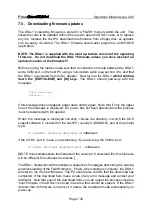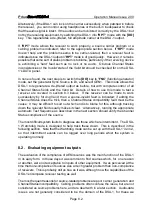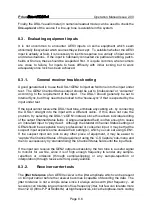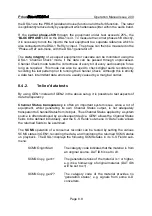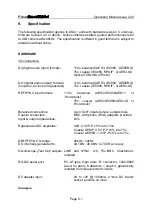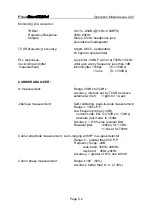
Prism
Operation Manual Issue 2.00
Page 8.5
Intrinsic jitter from a source is measured using the 'fs Jitter' sub-menu. There is no
proper specification for this parameter in the standard (see the footnote at the end of
this chapter). 40ns P-P is suggested (about 1/4 UI at fs=48kHz) but any source
supplying intrinsic jitter at this level would probably be beyond the grasp of some
receivers. It is unusual to see intrinsic jitter figures above 20ns these days, and most
good equipment will manage under 5ns. Any moderate figure should be acceptable,
except where non-jitter-attenuating converters are to be connected, in which case the
figure should be as low as possible, although the problem actually lies with the
converter. Remember to also check the intrinsic jitter with the source externally
synchronised to a low-jitter reference, if this is a system option. This can be done by
using the DSA-1's GEN2 (in internal Sync Mode) as the reference. On poor quality
equipment, the intrinsic jitter can be very much worse on external sync.
The eye-narrowing and data jitter readings should also be checked, mainly to verify
that none is present. These are cable effects and a source should not register anything
here if the cable to the DSA-1 is short, unless some distortion or band-limiting is
present in the AES3 output driver. Eye-narrowing should be zero, and data jitter should
be nominally equal to the previous fs jitter result. Likewise the biphase error count
should continue to register zero with a short cable unless the equipment is faulty.
If the source can be synchronised externally, the phase of its carrier output should be
checked with respect to the reference input using the 'Phase v. Ref' sub-menu. This
figure should be less than ±5%, although it is unlikely that any modern receiving
equipment would suffer audible problems whatever the output phase of the source,
since reframing hysteresis is usually included in AES3 receiver devices.
Check the figure for Wordclock as well as AES11 reference syncs, if these can both be
used.
8.2.3.
Source data tests
The correct operation of the Channel Status and Valid bits from the source should be
checked, although it is often hard to know exactly what to expect. Simple equipment
should issue 'Valid' (Valid bit = 0, DSA-1 'V' LED OFF) all the time, although non-audio
or compressed audio sources should show 'Invalid'. Uncorrectable errors or the STOP
or PAUSE state in some transports may also result in 'Invalid' indications. Various
levels of Channel Status implementation are now allowed although, in general,
professional equipment should at least have all fields in the first three bytes set
correctly plus a correct CRC to assure trouble-free interfacing. Consumer equipment
should correctly implement all fields in the first byte, and indicate the correct sampling
rate in byte 3. A non-copyright category code and 'copy permitted' should also be set
if the source is to be recorded on SCMS devices.
The audio word-length of the source can be checked using the DSA-1's 'active bits'
sub-menu. If the source equipment contains any digital processing, the output re-
dithering or noise-shaping can be examined using the DSA-1 Microscope mode as
described in section 8.4 below.









